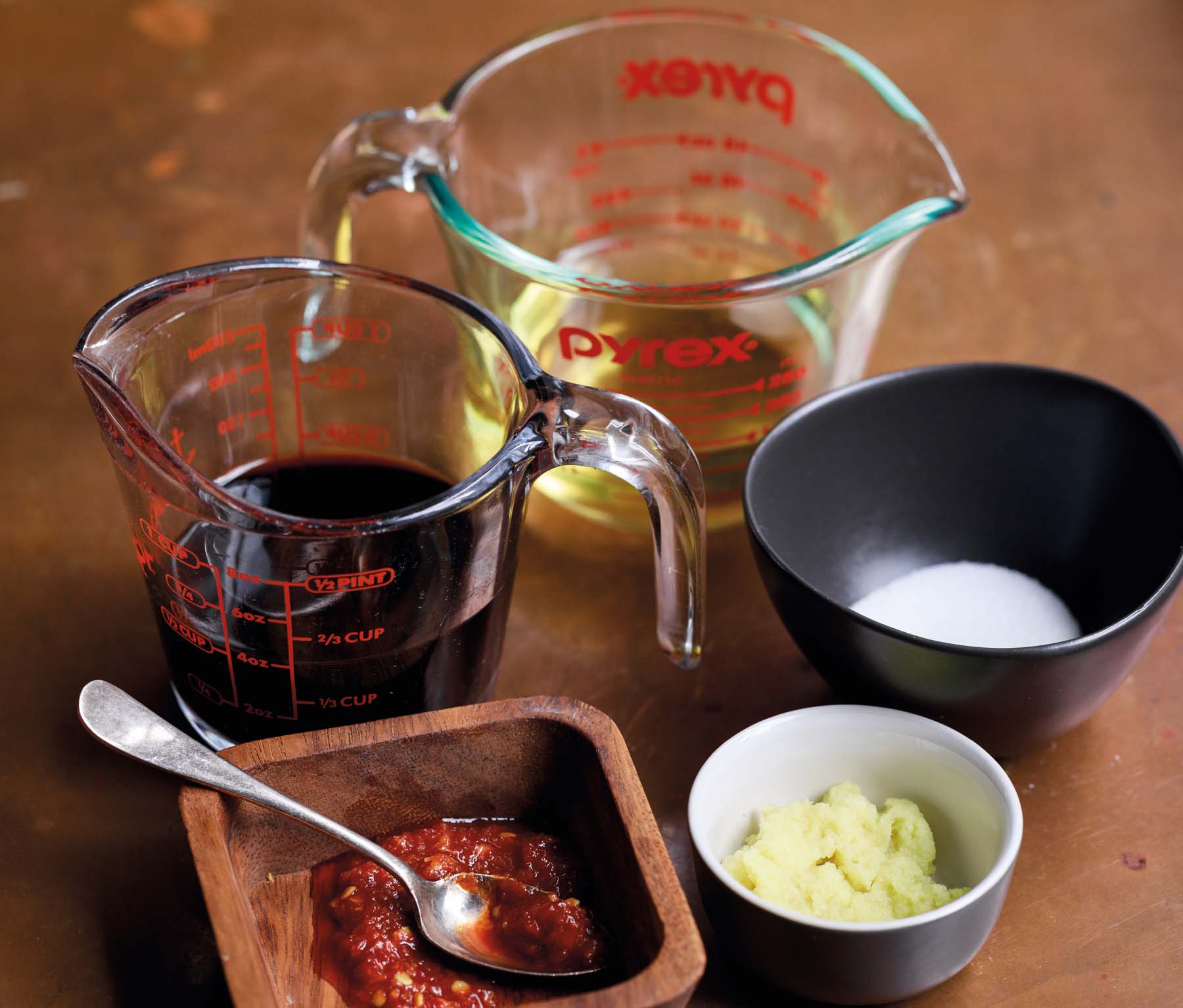MILK STREET PANTRY
BOOST FLAVOR FAST
Three Asian-Pantry Shortcuts to Deep, Rich, Savory Success
Miso, soy sauce and spicy gochujang paste are simple solutions for adding instant umami—that savory, simmered-all-day richness. Used widely in Asian cooking, they’re good in soups, sauces, noodles, stir-fries, dressings and more. These are Milk Street’s go-to choices and how we use them.
MISO
Miso is a Japanese staple typically prepared from fermented soy beans and grains, such as rice and barley. Two varieties are common in the U.S.—white (shiro), which has a mild, salty-sweet flavor; and red (aka), with a rusty hue and big, bold taste. Other types include yellow (shinshu), which falls somewhere between white and red; barley (mugi); brown rice (genmai); and miso made with 100 percent soybeans (hatcho). Miso often is used in soup, but also can boost the flavor of many dishes.
In broth: Miso broth can be cooled and stored in an airtight container in the refrigerator for up to five days. The miso will settle upon standing, so stir to recombine before using. Our recipes take 10 minutes and make about 1 quart each.
In sauces and compound butter: Whisk a spoonful into pan sauces for meat or poultry or even into roux-thickened gravies, or mash an equal amount with softened butter and, if you like, some grated fresh ginger. The butter is great tossed with hot noodles or pasta or melted onto roasted or grilled vegetables.
In vinaigrette: To make a miso-ginger dressing, in a blender, combine 1/3 cup walnuts, 1/3 cup white miso, 1 teaspoon grated lemon zest, ¼ cup lemon juice, ¼ cup water, 1-ounce piece fresh ginger (peeled and thinly sliced), 1 teaspoon Dijon mustard, 1 teaspoon honey and ½ teaspoon ground white pepper. Blend until smooth, about 1 minute. Add ½ cup grapeseed or other neutral oil and blend until emulsified, about 30 seconds.

MISO BROTH RECIPES
Red Miso Broth
In a large saucepan over medium, combine 4 medium garlic cloves (smashed and peeled) and 2 tablespoons tomato paste. Cook, stirring occasionally, until the tomato paste has browned, 2 to 3 minutes. Add 4 cups water, then whisk in ½ cup red miso. Bring to a gentle simmer, then reduce to medium-low and cook, stirring occasionally, for 5 minutes. Strain through a fine mesh strainer set over a medium bowl. The broth can be used in recipes in place of chicken or beef broth and is appropriate in hearty stews and braises.
White Miso Broth
In a large saucepan over medium, cook 4 medium garlic cloves (smashed and peeled), 1 ounce fresh ginger (peeled and smashed) and 1 medium shallot (roughly chopped), stirring occasionally, until beginning to brown, about 2 minutes. Add 4 cups water, then whisk in ½ cup white miso. Bring to a gentle simmer, then reduce to medium-low and cook, stirring occasionally, for 5 minutes. Strain through a fine mesh strainer set over a medium bowl. This broth can be used in place of chicken broth or stock and as a poaching liquid for chicken or seafood.
SOY SAUCE
Soy sauce traditionally has been made with a combination of soy beans and roasted wheat that has been cultured, then mixed with a hefty saltwater solution and fermented. Though the condiment is produced in many Asian countries, the dominant varieties are from Japan and China. Japanese soy sauce (shoyu) typically is made with more wheat and tends to be lighter in viscosity and less salty than Chinese soy sauce (jiangyou). When we call for soy sauce, it’s usually standard Japanese dark soy sauce (koikuchi shoyu), which is widely available. Whatever variety or brand you buy, check the label. Look for the phrase “naturally brewed” or “fermented.” Soybeans, wheat, salt and water should take the lead in the ingredient list. Here is a guide to common soy sauces.
Japanese dark soy sauce (koikuchi shoyu) is the type most widely available in supermarkets. This is the default in Japanese cooking and what we use, too; if a Japanese brand doesn’t specify which type of soy sauce it is, it’s koikuchi. It is darker in color but is neither saltier nor stronger than Japanese light soy sauce (usukuchi shoyu), so don’t be fooled. Soy sauce is used as a seasoning in marinades, sauces, glazes, soups and stews. It’s also the base for many dipping sauces and is a standard condiment on the Asian table. In applications where regular soy sauce is too salty, we sometimes call for low- or reduced-sodium soy sauce.
Tamari is made with little to no wheat and, as a result, has a strong soy flavor. The Japanese product—some would argue it’s not a soy sauce at all—is more viscous and darker than koikuchi. It’s often used as a gluten-free alternative to soy sauce. If you are avoiding gluten, make sure the tamari’s label reads “gluten-free” or check the ingredient list to see if it contains wheat.
Sweet soy sauce (kecap manis) is dark, syrupy, sweet and Indonesian in origin. Its flavor contains notes of bittersweet molasses and smoky spices. (Chinese sweet soy sauce is somewhat milder in flavor and less viscous.) Kecap manis is used liberally in Indonesian cooking for marinating, in noodle dishes and stir-fries, as well as in dipping sauces. We include a recipe for making your own.
SOY SAUCE RECIPES

Soy Dipping Sauce
In a medium bowl, whisk together ½ cup soy sauce, ½ cup unseasoned rice vinegar, 1 tablespoon finely grated fresh ginger, 1 tablespoon white sugar and 2 teaspoons chili-garlic sauce. Cover and refrigerate up to 3 days.
Indonesian-Style Sweet Soy Sauce (Kecap Manis)
In a small saucepan over medium-high, combine 1 cup firmly packed dark brown sugar and ½ cup water. Bring to a simmer, stirring to dissolve the sugar, then reduce to medium and cook until syrupy and reduced to about ¾ cup, 10 to 12 minutes. Transfer to a small bowl or jar and let cool slightly. Stir in ¼ cup soy sauce, then cool to room temperature.
GOCHUJANG
Many of the core flavors of Korean cuisine are built on a family of fermented soy-based condiments, each of which is considered a jang. The simplest—made from soy beans, salt and water—is ganjang, or soy sauce. One of the most complex—and the most popular in the U.S.—is gochujang, a spicy red paste with a consistency and savoriness similar to Japanese miso. Traditional methods for making it call for hand mixing a slurry of soy sauce, sticky rice, salt, malt and chili powder, then fermenting it in large clay pots left outside in the sun. The pots—called onggi—are porous, which helps foster fermentation. Though six months is acceptable, the best gochujangs are aged as long as five years. It works as flavoring in marinades, soups, stews, sauces and stir-fries, as well as a table condiment.
